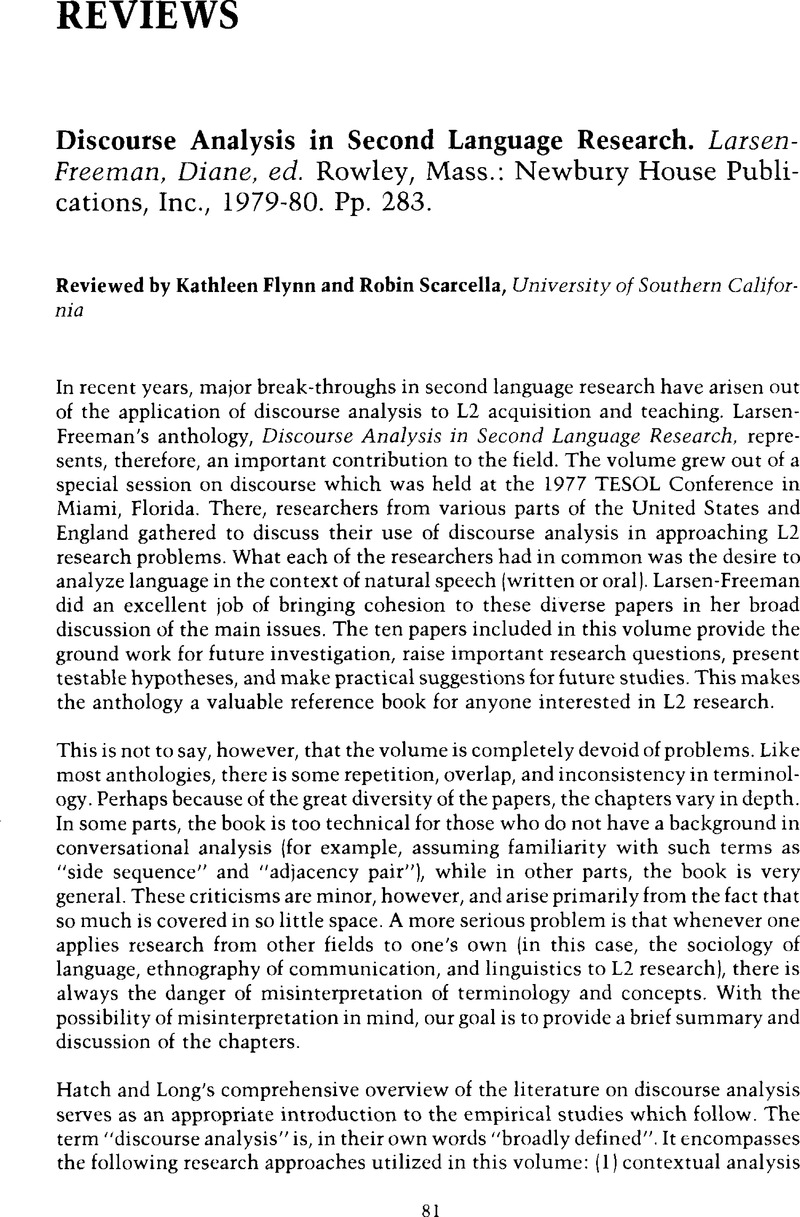No CrossRef data available.
Article contents
Discourse Analysis in Second Language Research. Larsen-Freeman Diane, ed. Rowley, Mass.: Newbury House Publications, Inc., 1979–1980. Pp. 283.
Review products
Discourse Analysis in Second Language Research. Larsen-Freeman Diane, ed. Rowley, Mass.: Newbury House Publications, Inc., 1979–1980. Pp. 283.
Published online by Cambridge University Press: 07 November 2008
Abstract
An abstract is not available for this content so a preview has been provided. Please use the Get access link above for information on how to access this content.

- Type
- Reviews
- Information
- Copyright
- Copyright © Cambridge University Press 1981
References
Andersen, E. and Johnson, C.. 1973. Modifications in the speech of an eight-year old as a reflection of age of listener. Stanford Occasional Papers in Linguistics, 3.149–60.Google Scholar
Brunak, J. and Scarcella, R.. 1980. On speaking politely in a second language. On TESOL '80. C. Yorio, K. Perkins and f. Schachter, Washington D.C.Google Scholar
Cazden, C.H.; Cancino, E., Rosansky, E.; and Schumann, J.. 1975. Second language acquisition sequences in children, adolescents, and adults. Final report, National Institute of Education (Grant NE-6–00–3–0014).Google Scholar
Chafe, W. 1980. Cognitive, cultural, and linguistic aspects of narrative production. The Pear Stories, ed. by Chafe, W.. Norwood, New Jersey: Ablex Publishing Corporation.Google Scholar
Cohen, A. and Olshtain, E.. Forthcoming. Developing a measure of sociocultural competence: the case of apology. Language Learning.Google Scholar
D'Amico-Reisner, L. 1980. Expressions of disapproval: an examination of the speech act in non-native speaker speech. Unpublished ms. University of Pennsylvania.Google Scholar
Dulay, H. and Burt, M., 1974. A new perspective on the creative construction process in child second language acquisition. Language Learning, 24.253–78.CrossRefGoogle Scholar
Gleason, J.B. 1973. Code-switching in children's language. Cognitive development and the acquisition of language. T. E. Moore, New York: Academic Press.Google Scholar
Grice, H.P. 1967. Logic and conversation. William James Lectures, Howard University. Syntax and Semantics, vol. 3: Speech Acts. Ed. by Cole, P. and Morgan, J.L., 1975: Seminar Press.Google Scholar
Hatch, E., Shapira, R. and Gough, J.. 1975. Foreigner talk discourse. Unpublished ms., University of California, Los Angeles.Google Scholar
Hymes, D. 1971. On communicative competence. Philadelphia: University of Pennsylvania Press.Google Scholar
Keenan, E.O. 1977. Why look at planned and unplanned discourse? Discourse across time and space, ed. by Keenan, E.O. and Bennett, T.L.. SCOPIL. University of Southern California.Google Scholar
Krashen, S. 1980. Second language acquisition and second language learning. New Jersey: Pergamon Press.Google Scholar
Long, M.H. 1980a. Inside the ‘open black box’ method: Issues in language classroom research. Language Learning, 13.1–42.CrossRefGoogle Scholar
Long, M.H. 1980b. Input, interaction, and second language acquisition. Unpublished PhD dissertation, University of California, Los Angeles.Google Scholar
Olshtain, E. 1981. Sociocultural competence and language transfer: The case of apology. Paper presented at the 1980 Conference on Language Transfer, Ann Arbor, Michigan.Google Scholar
Sacks, J. and Devin, J.. 1976. Young children's use of age-appropriate speech styles in social-interaction and role-playing. Journal of Child Language, 3.81–98.CrossRefGoogle Scholar
Sacks, H.; Schegloff, E.; and Jefferson, G.. 1974. A simplest systematics for the organization of turn-taking for conversation. Language 50.696–735.CrossRefGoogle Scholar
Sacks, H.; Schegloff, E.; and Jefferson, G.. 1977. The preference for self-correction in the organization of repair in conversation. Language 53.361–82.Google Scholar
Searle, J.R. 1971. What is a speech act? The Philosophy of Language, ed. by Searle, J.. Oxford: Oxford University Press.Google Scholar
Searle, J.R. 1975. Indirect speech acts. Syntax and Semantics, vol. 3: Speech Acts. ed. by Cole, P. and Morgan, J.L.. New York: Seminar Press.Google Scholar
Shatz, M. and Gelman, R., 1973. The development of communication skills: modifications in the speech of young children as a function of listeners. Monographs of the Society for Research in Child Development, 38 (5, Serial no. 152).CrossRefGoogle Scholar
Slager, W. 1973. Creating contexts for language practice. TESOL Quarterly, 7.35–50.CrossRefGoogle Scholar
Wolfson, N. 1976. Speech events and natural speech: some implications for sociolinguistic methodology. Language in Society 5.189–209.CrossRefGoogle Scholar


